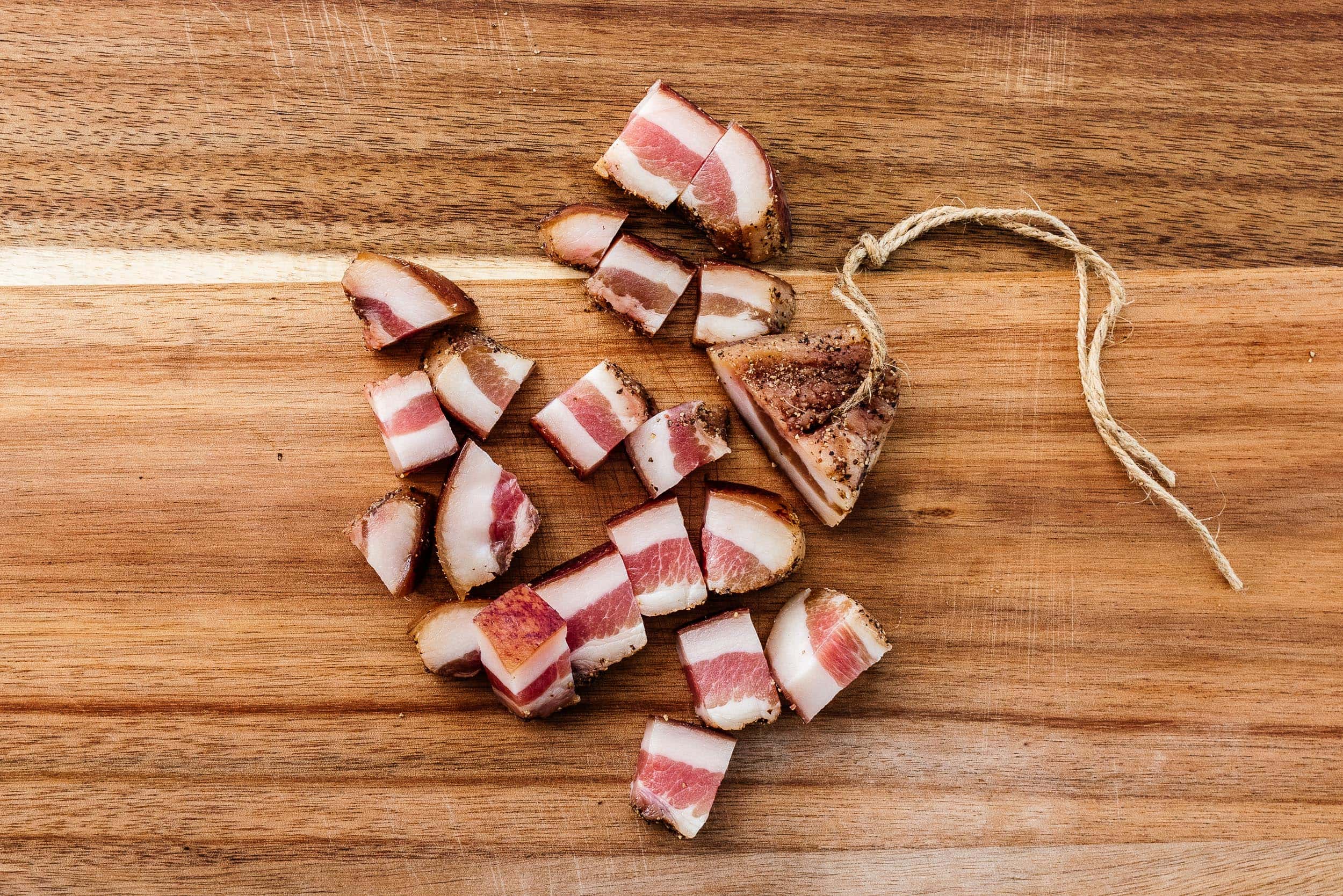Discovering Guanciale: The Secret Ingredient in Italian Cuisine
If you’ve ever savored a plate of carbonara at an exceptional Italian restaurant, you may have experienced the delightful crunch and rich flavor of guanciale. This unique cured pork cheek is not just an ingredient; it’s a culinary treasure that elevates dishes with its sweet, crispy texture and intense umami profile.
What Exactly is Guanciale?
Guanciale is an Italian delicacy made from cured pork cheek or jowl. Renowned for its high fat content, it’s ideal for curing with salt and aromatic herbs. This results in a product that boasts a salty yet incredibly rich flavor, reminiscent of pancetta but with its own distinct character.
The Flavor Profile of Guanciale
The taste of guanciale strikes a perfect balance between sweetness and savoriness. It offers a luxurious buttery richness combined with an unmistakably porky essence. When cooked, the rendered fat releases fragrant notes that are both sweet and savory without being overly salty. Each bite delivers concentrated pork goodness thanks to the curing process.
Where to Find Guanciale
You can purchase guanciale at specialty Italian delis or online retailers like Amazon. Some upscale grocery stores may also carry this sought-after ingredient.
#### Cooking with Guanciale
To prepare guanciale, slice or cube it and cook it slowly over low heat until the fat has rendered out completely. This technique allows you to incorporate the flavorful fat into sauces like carbonara or alla gricia while using the crispy meat as a topping for your pasta dish. Additionally, guanciale can enhance sautéed greens, beans, stews, and ragùs.
Culinary Uses for Guanciale
Guanciale adds depth and richness to various recipes beyond traditional pasta dishes such as:
- Carbonara - Amatriciana
- Alla Gricia
It can also be substituted for pancetta in recipes including:
- Bolognese
- Braises
- Ragùs
- Sautéed greens
- Soups
Comparing Guanciale to Pancetta
The primary distinction between guanciale and pancetta lies in their cuts: guanciale comes from the cheeks while pancetta is derived from pork belly. Furthermore, their curing processes differ; guanciale incorporates spices alongside salt during curing whereas pancetta relies solely on salt.
Guacialle: Cured using salt and spices from pork cheeks; richer flavor due to higher fat content.
Pancetta: Cured only with salt (and sometimes pepper) from pork belly; slightly less fatty but more on the salty side.
Comparing Guanicalle to Bacon
Similarities exist between guanicalle and bacon as well—both are cured meats but differ significantly in cut (cheek vs belly) as well as preparation methods (bacon is typically smoked). As such, bacon carries a distinct smoky flavor absent in guanicalle.
Substitutes for Guacialle
If you can’t find guacialle locally or online, consider using either bacon or pancetta as alternatives—though keep in mind that bacon will impart smokiness while pancetta lacks some of those delicate spice notes found in gualcialle.
### Storing Your Guacialle
To store your leftover gualcialle effectively: wrap what you need tightly in kitchen paper before placing it into your refrigerator—avoid plastic wrap which can cause condensation leading to sogginess! Properly stored gualcialle can last up six months refrigerated without losing quality.
Recipe Spotlight: Pasta alla Gricia Featuring Gualcialle
Serves: 2
Prep Time: 2 minutes
Cook Time: 13 minutes
Total Time: 15 minutes
Ingredients:
- 4 oz cubed gualcialle
- 6 oz pasta (your choice)
- 3 oz finely grated Pecorino Romano cheese
- Freshly ground black pepper (at least 2 tsp)
- In a nonstick skillet over medium-low heat crisp up your cubed gualciallle until all fats render out.
- Once done cooking transfer them into another bowl then set aside.
- Meanwhile boil water & cook chosen pasta until three minutes shy according package instructions saving about one-and-a-half cups worth before draining without rinsing! 4.Add three-fourths cup reserved water back into skillet bringing gently boil stirring often emulsifying together rendered fats & liquid about one minute long! 5.Add drained al dente pasta tossing continuously till sauce thickens glossy around two more minutes! Use silicone tongs if needed so they don’t break apart easily! 6.Turn heat up medium-high adding back crisped cubes along freshly cracked pepper plus two-thirds grated cheese mixing thoroughly melting everything together beautifully!
Serve immediately topped off remaining Pecorino Romano!
Nutritional Information per Serving:
Calories: 570
Calories From Fat: 252
| Nutrient | Amount | % Daily Value* |
|---|---|---|
| Total Fat | 28g | 43% |
| Saturated Fat | 15g | 99% |
| Cholesterol | 147mg | 49% |
| Sodium | 1317mg | 57% |
| Potassium | 152mg | 4% |
| Carbohydrates | 46g | 16% |
| Fiber | – | - |
| Sugar | – | – |
| Protein | 29g | 58% |
*Percent Daily Values based on a standard diet containing approximately 2000 calories daily
Indulge yourself today by incorporating this exquisite ingredient into your next meal!

